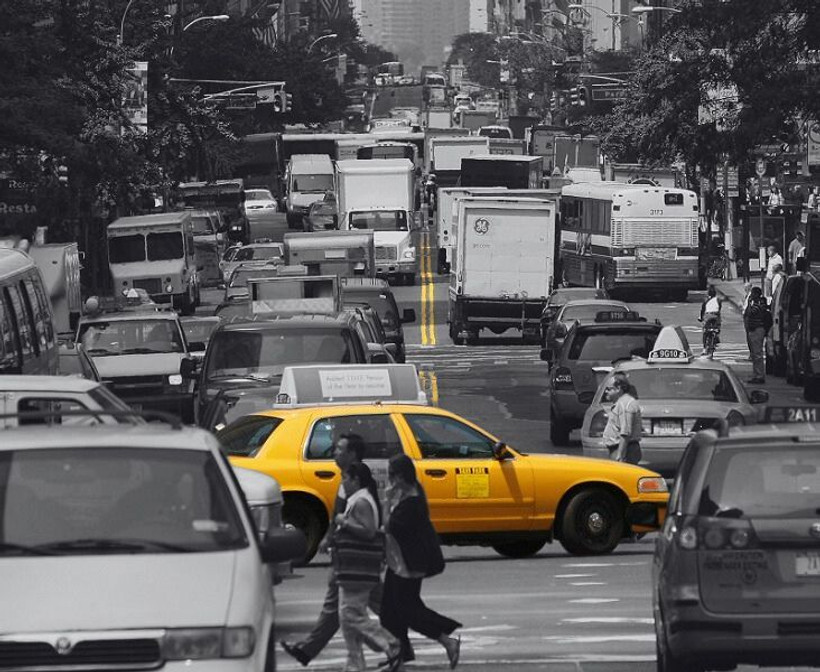Traffic in Manhattan has never been this bad. Relief was on its way — but like an ambulance stranded behind a double-parked truck, it’s been stopped in its tracks.
Governor Kathy Hochul’s last-minute decision to pause congestion pricing has dimmed hopes of reducing traffic in the perpetually gridlocked streets of lower Manhattan. Traffic speeds there have plunged to the slowest ever recorded, according to longtime traffic guru Sam Schwartz.
Below 60th street, in the so-called Central Business District where the program would have applied, the average taxi speed last month was 6.6 miles per hour — about the same as an in-shape jogger. (The city uses taxis as a barometer of overall car speed.) That was the slowest May on record, according to data Schwartz provided to New York Focus.
In Midtown Manhattan, the average taxi speed in May was 4.5 miles per hour — barely faster than a brisk walk.
At this speed, a New Jersey driver trying to eat at the Hochul-endorsed Comfort Diner on East 45th Street would take 27 minutes to drive the two miles from the exit of the Lincoln Tunnel to the source of the egg cream they might be craving, not including the time it would take to find parking. Taking the 7 train the same distance would take five minutes less, and a Citibike would cut the trip time to 15 minutes. (Explaining her decision last Friday, Hochul pointed to diners that could lose New Jersey customers.)
The governor’s decision has infuriated a broad spectrum of congestion pricing supporters, from the Democratic Socialists of America to the business group Partnership for New York City.
“Congestion pricing will enhance affordability of the city because it won’t just improve transit, but it will reduce the huge economic cost associated with gridlock,” said Kathryn Wylde, the CEO of the Partnership. “We thought we were going to get a reprieve, that things were going to move.”
According to a 2018 survey conducted by engineering firm HDR on behalf of the Partnership, traffic congestion in the New York City metropolitan area led to over $9 billion in costs due to travel delays, and another $2.5 billion due to excess fuel and vehicle use.
That’s without counting the safety and health risks of constant traffic. In Manhattan alone, 28 people were killed in crashes last year and nearly 6,000 were injured, according to city data. Death rates haven’t budged in recent years, despite a concerted push to make the city’s streets safer.
“Every crash leaves a hole,” said Kate Brockwehl, a member of the group Families for Safe Streets, who was hit by a car while crossing Houston Street on foot in 2017. The crash tore her meniscus and ligaments in both wrists, and left her with lasting PTSD, she said.
Studies have shown that fatal crashes dropped by as much as 46 percent in central London after the city enacted its congestion charge there, and dropped outside the toll zone, too.
London’s air quality has also improved in recent years.
In New York City, air pollution has ticked upwards over the last five years, according to data provided to New York Focus by the firm IQAir. Glory Dolphin Hammes, the firm’s North America head, said traffic is one of the biggest factors shaping air quality in US cities.
Pollution from vehicles causes hundreds of premature deaths each year across New York City, research has found. Hammes said reducing that pollution would require an “all of the above approach,” including vehicle electrification and better city planning to reduce car dependency.
A 2023 MTA study estimated that the congestion pricing program would reduce the number of cars and trucks entering the zone by 17 percent, while also easing congestion in the rest of the city and its suburbs. More than 90 percent of people who currently drive to the congestion zone for work have easy access to mass transit, the study found.
Kate Slevin, executive vice president of the Regional Plan Association, attributed worsening traffic to rideshare apps and e-commerce.
“Every time you put an order in on Amazon, it has a truck delivering straight to your apartment,” Slevin said. “More trucks that need to make deliveries cause congestion at the curb, and that slows the traffic down.”
Under the congestion pricing scheme, trucks would be charged between $24 and $36 to enter downtown Manhattan during peak hours, incentivizing companies to consolidate deliveries into fewer trips. The city’s 80,000 rideshare vehicles would be charged $2.50, a smaller amount but enough to nudge some riders to take public transit instead.
Hochul’s decision puts plans to upgrade the aging subway and commuter rail systems on life support, too. At a press conference Monday, Metropolitan Transit Authority CEO Janno Lieber said that without the toll income, the MTA will be required to spend its limited resources on basic maintenance, and potentially shelve accessibility upgrades and new projects like the expansion of the Q train to Harlem or the Interborough Express.
Hochul has declined to say how long the pause will last. Wylde, the business group CEO, hasn’t been able to get an answer to that question either, she said.
“If Trump is elected, if we don’t have it in place and federally signed off by the end of the year, it’s dead. So in my mind, the end of the year is the deadline,” Wylde said.

